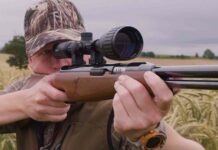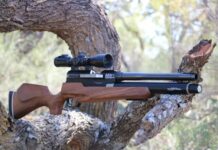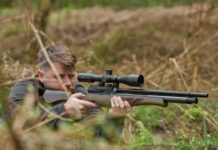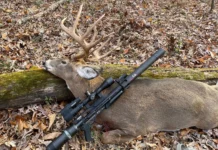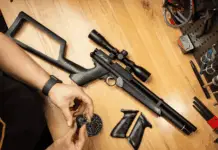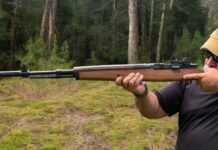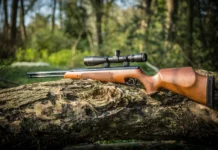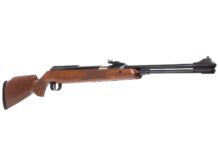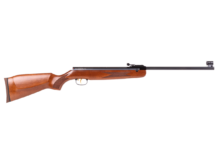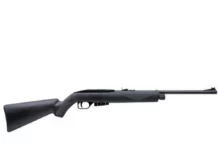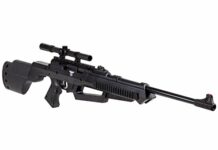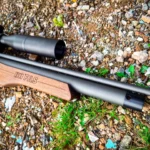I was recently trying to find out the effective range of a variety of different bows and crossbows. I had some difficulty quickly finding all the info I wanted. So I decided to compile the information myself and share it with you. To begin, here is the short answer:
The maximum range of a bow is about 200 to 500 yards, but the effective, accurate range for target shooting is 150 yards to 350 yards depending on the bow type and draw weight. The maximum hunting range for most bow types is 30 to 60 yards for an experienced hunter and 15 to 25 yards for beginners.
Here is a chart that will give you a good idea of what the range of each type of bow looks like.
Maximum and Effective Ranges of Various Bow Types:
Many factors contribute to the determination of how far a particular bow will shoot. Factors such as the style of bow, the draw strength of the bow, the type and weight of the arrow, and environmental conditions. The combination of these factors and the skill of the archer will determine the effective range of the bow.
Table of Contents
What Determines How Far A Bow Can Shoot?
The distance that a bow can shoot depends on a number of elements that pertain to the design and manufacture of the equipment. This includes the bow itself as well as the arrows.
The following are determining factors for the range of the bow.
- Style of the bow- The bow’s design and style play a vital role in its effectiveness and the range it will be able to achieve.
- The bow’s material- The material the bow is made from will influence its ability to store the energy when drawn and how efficiently it can transfer that energy to the arrow when the string is released.
- The construction of the arrow- Arrows are made with a wide variety of designs. Each is intended to serve a different purpose and will affect the distance that they can achieve. The most influential component is in the design of the fletching.
- The weight of the arrow- Lighter arrows will travel further but will be affected or deflected by wind and obstacles such as branches. This makes them less accurate, and they do not deliver as much impact when they strike the target, which can limit penetration. Heavier arrows will not travel as far because they have a slower speed, but they will be more accurate than lighter arrows and deliver a more penetrating impact to the target. The range of a heavier arrow will be less than that of a lighter arrow.
- Environmental conditions- Windy conditions will affect the distance that a bow can shoot and the shot’s accuracy. Archers often have to compensate for the wind when taking longer shots.
I recommend getting a good rangefinder like this one found on Amazon if you want to do your own tests and practice to extend your accurate range.
Related Best Binoculars for Archery | Field or Indoor Use.
What Types Of Bows Are There?
Bows have been around since ancient times and were one of the early tools that man developed to hunt wild game and defend themselves. Technology has progressed and evolved into the modern bows that we have today.
There are variations and different styles of bows, each with its advantages and disadvantages. They all, however, use the same principle of launching a projectile by storing energy in the bow, which is transferred to the arrow, the projectile, via the drawstring when the tension is released.
The bow has evolved into four main types, the longbow, recurve bow, compound bow, and crossbow. Each of them has characteristics that give them strengths in certain areas and limitations in others.
The LongBow
The longbow is so named because it is a physically large bow, usually the same height as the archer. The average height of these bows was about 72 inches or 1.82 meters.
These bows were developed as effective weapons of war and also for hunting purposes. They were famed for being able to shoot long distances, and the English longbow archers were feared soldiers that changed the course of early medieval battles.
Traditionally, these bows are made from wood, but modern versions are also made from fiberglass. The range of bows made from these materials are similar, but the wooden bows require more care and cannot be left strung for long periods of time since the wood will set and take on the curved shape, which will reduce the elasticity of the bow and thus, reduce its effective range.
Recurve Bows
A recurve bow is given this name because the tip of the limbs of the bow curves away from the archer as opposed to towards the archer, as is the case with a longbow.
The shape of the recurve bow allows the bow’s limbs to store much more energy than the traditionally shaped bows.
The shape allows for shorter bows, and for this reason, the recurve bow became popular for use by archers mounted on horseback.
From a survival perspective, these bows may have more power than a longbow, but they also make significantly more noise when the arrow is released. If stealth is a requirement that you look for in a bow, a longbow will provide more stealth when taking the shot than a recurve bow would.
The recurve of the bow has limitations, and therefore it needs to be made within specific parameters. If the recurve is too extreme, the bow becomes unstable and difficult to string.
The extra power that the shape provides to the recurve bow translates into a decent range for this style of bow. The additional power and the portability of this bow because of its smaller size make it popular for people who hunt in wooded or bushy locations.
Compound Bows
Compound bows resemble a couple of sticks held together with a spiderweb! The principle behind the technology of the compound bow is leverage. Then the bow is drawn, a complex system of cables and pulleys activate the limbs of the bow and load them in preparation for release.
Using the leverage principle, the compound bow’s limbs can be much stiffer than other bow designs. As a result, the archer will still be able to draw the bow because of the mechanical advantage gained by the leverage system.
The relative ease of drawing a compound bow means that the archer does not need vast strength to shoot the bow. The archer can also shoot more accurately because of the lower effort required to draw the bow.
The compound bow is considered a modern bow since the concept was only conceived in the late 1960s, while the other bow designs have a history dating back hundreds and, in some cases, thousands of years ago.
The ability the compound bow gives the archer to draw a bow with very stiff limbs makes these bows very powerful, which also provides this bow an exceptional range.
Crossbows
The crossbow uses the same principle of storing energy in the limbs of the bow and translating the stored energy to the projectile, called a bolt, via the string of the bow. Early crossbows were very difficult to cock the weapon and lock the string back in the drawn position. It required a lot of strength on the part of the shooter.
However, once the crossbow was ready to shoot, the archer could take their time sighting the target since strength is not required to hold the string in the drawn position. A simple trigger mechanism is used to release the string and launch the bolt.
Modern crossbows come in different styles, and some employ compound bow principles to make the act of drawing the string of the crossbow back into position much easier for the shooter.
A crossbow’s limbs are limited in size because of the shooting position, which is similar to a modern-day rifle. For this reason, crossbows are not considered long-range weapons.
The crossbow can be successfully used for hunting, but you will need to get as close to your quarry as for a compound bow.
What is Draw Strength And Draw Weight?
You will often hear about a bows draw weight, which is referenced in pounds. This metric is sometimes also referred to as the bow’s “draw strength” since the archer needs a certain strength level to handle a bow of a particular draw weight.
The draw weight of a bow contributes significantly to how easy or difficult the bow will be to shoot, but it will also determine the bow’s effective range.
The draw weight expressed in pounds (lbs.) is the amount of force needed to draw the bow and the amount of energy transferred to the bolt or the arrow.
The draw weight is influenced by the draw length of the bow. The draw length of a bow is the maximum distance that the bow can be drawn back by the shooter.
The draw length is, in turn, determined by the physical stature of the shooter and their ability to draw the bow.
The industry standard at which the bow draw weight is measured is 28 inches. So, if a bow has a 45lbs draw weight, this will be the force required to draw the string to a distance of 28 inches.
Maximum Range Of A Bow
Because of the differences in bow design, varying types will have different maximum ranges due to the materials they are made from and their draw weight. For this reason, we will need to compare the distances that can be achieved for each bow type with different draw weights.
The Longbow Range
Old world longbows were significantly more powerful than modern longbows since they were mostly manufactured as weapons of war. Some ancient texts report draw weights of up to 180lbs and longbow ranges that exceeded 400yds, or 365 meters.
Modern longbows are manufactured with much lower draw weights, and as a result, their maximum range is somewhat less, between 200 to 300 yards (182 – 274m).
The longbow’s accurate range is less than the maximum range and is 100 to 200 yards or 90 – 180 meters.
The longbow’s effective rangeis considered the range at which it is viable for hunting and would be a similar range for self-defense. The effective range of a modern longbow is between 60 to 80 yards.
The longbow does not have the same range as the more powerful recurve bow, but it is more accurate towards the top end of its range than what the recurve bow is.
The longbow has lost some of its popularity as a hunting weapon and for self-defense because of both its size and raw materials. Many of these bows are still made from wood, which is susceptible to damage if it becomes wet or is exposed to excessively moist or arid environments.
These bows require much more maintenance and cannot be left strung since the wood will set in the strung positions and lose its elasticity and thus reducing the bow’s power.
The Recurve Bow Range
The recurve bow is an improvement on the longbow’s design and is thus a more powerful bow. How does the extra power translate into the recurve bow’s maximum and effective range?
The recurve bow’s maximum range, depending on the draw weight, is between 280 yards and 300 yards. At these distances, however, the shooting will not be accurate and could not be expected to be considered a normal shooting distance for target shooting or hunting. The longbow is more accurate at these distances, but the recurve bow has greater power at these ranges.
The accurate range for target shooting for the recurve bow is between 60 to 100 yards.
Hunting Range
For hunting, the effective range of the recurve bow is somewhere between 20 yards and 40 yards, depending on the draw weight of the bow and the archer’s competency.
The reason that hunters still hunt with recurve bows is that they are the closest you can get to traditional-style bows while still making use of modern materials. The greater force that the recurve bow generates also gives the arrow a harder impact on the hunted animal.
This means that the arrow stands less chance of being deflected by wind, grass, or twigs and will have a deeper penetration into the animal being hunted.
Recurve bows are popular in the survival community because they are stronger and more robust than the longbow and less complicated than the compound bow or the crossbow.
Some modern recurve bows have removable limbs, which enables you to assemble and disassemble the bow quickly. This makes it easy to carry disassembled in a backpack where it will be out of the way until you are ready to hunt.
The simplicity of the bow and the fact that there is not much that can go wrong with the mechanism continues to make this style of bow popular with survivalists and homesteaders and a self-defense weapon as well as a reliable hunting tool.
The Compound Bow Range
The compound bow and the modern crossbow are probably the most popular type of bows for both sport shooting and hunting.
The technology of the compound bow gives the shooter much more power in the shot for a lot less effort on the part of the archer.
The maximum distance that a compound bow can shoot is in the range of 300 to 350 yards. Once again, this distance is how far the arrow will fly, but it is not possible to shoot accurately over this distance.
The accurate range of a compound bow on a static target is between 80 to 100 yards depending on the archer’s ability and the bow’s draw weight.
These longer accurate distances are possible because the technology of the compound bow allows the archer to easily draw a bow with limbs that are made from a stiffer material. This gives the arrow more velocity, impact power, and accuracy than any of the other bows we have discussed thus far.
The compound bow’s effective range can be further than that of the other bows in the hands of an experienced compound bow archer, something like 60 to 70 yards. However, the generally accepted effective hunting range with a compound bow is between 30 and 60 yards.
The Crossbow Range
The crossbow, particularly the modern version, is easy for most people to shoot because the shooting position is the same as that of a rifle. Most people are familiar with this position, and they do not have to learn a new shooting position as they would have to with other style bows.
The rifle shooting position also allows for greater stability, which helps with accuracy when shooting the crossbow.
The maximum distance that a crossbow can launch its bolt is around 500 yards, which I quite impressive for such a relatively small bow-style weapon. Of course, at this distance, the crossbow is not remarkably accurate.
With a lot of target shooting practice, you can expect a range of between 180 yards and 200 yards. This distance is affected by the shorter bolt that is used as a projectile in a crossbow. This means that you may squeeze some more distance out of a longer bolt.
For hunting, 80 yards would be at the outer limits of the crossbow, and this would be considered a very long shot. Making a shot of this distance successfully on a deer will have your buddies talking for years to come about your prowess with the crossbow.
A more acceptable and common hunting range for a competent crossbow hunter would be more in the range of 60 yards. If you are new to the crossbow and bowhunting in general, you would probably be safer sticking to the 25 yards to 35 yards range.
How Far Is Too Far To Shoot A Deer With A Bow?
Hunting with a bow is an activity that has seen growing popularity in the hunting community. For many hunters, it provides a much greater challenge than using a rifle.
Hunting with a bow requires much more stealth and cunning because you have to get much closer to the hunted animal before you can release your shot. This type of hunting pits your wits and skill against that of the animal and makes for a much more exciting hunt.
The effective distance at which you can hunt a deer with a bow will vary depending on several variables:
- The bow’s draw weight- This affects not only the distance from which you can shoot but also the penetration expectancy of the arrow. Some states have minimum draw weight limits for hunting deer.
- Weight of the arrow- The weight of the arrow used for hunting needs to be such that it has enough weight for good penetration but not so heavy that the arrow’s flight path degrades too fast.
- Skill and confidence of the shooter- When you hunt, you want to make the shot clean, efficient, and cause as little stress to the animal as possible. To this end, it is crucial that a bow hunter only takes a shot at a distance that he is comfortable shooting at and has practiced this shot range sufficiently.
In bow shooting, there are rule of thumb distances that hunters can use as guidelines for acceptable shooting ranges for deer depending on their skill level.
- Advanced level. An advanced, experienced hunter with quality bowhunting equipment can attempt a shot up to 80 yards distant. However, this would be classified as a long shot and should only be attempted by advanced-level bow hunters.
- Experienced bow hunters. The more generally accepted distance for most bowhunters is in the range of 30 yards to 60 yards. Within this range, the hunter can shoot within his comfort zone, which is the distance he is most comfortable shooting at.</
